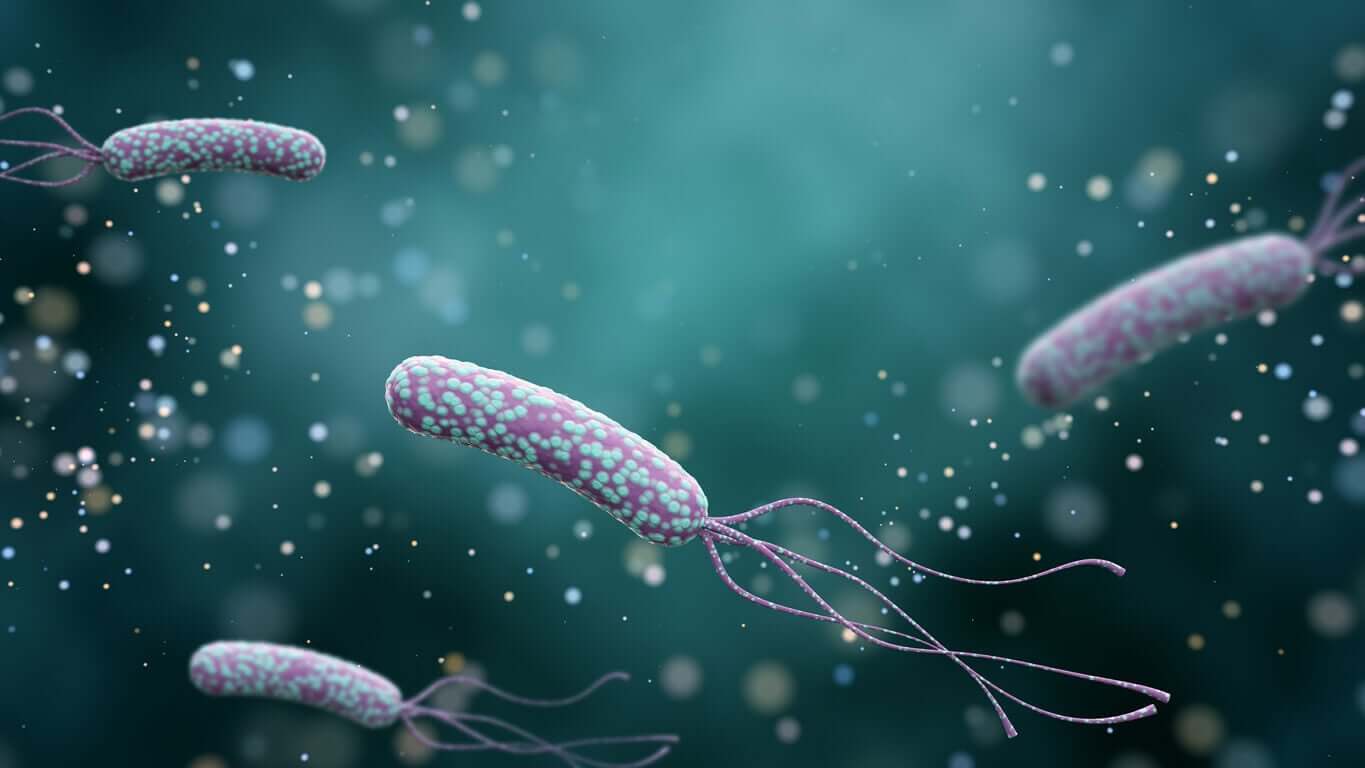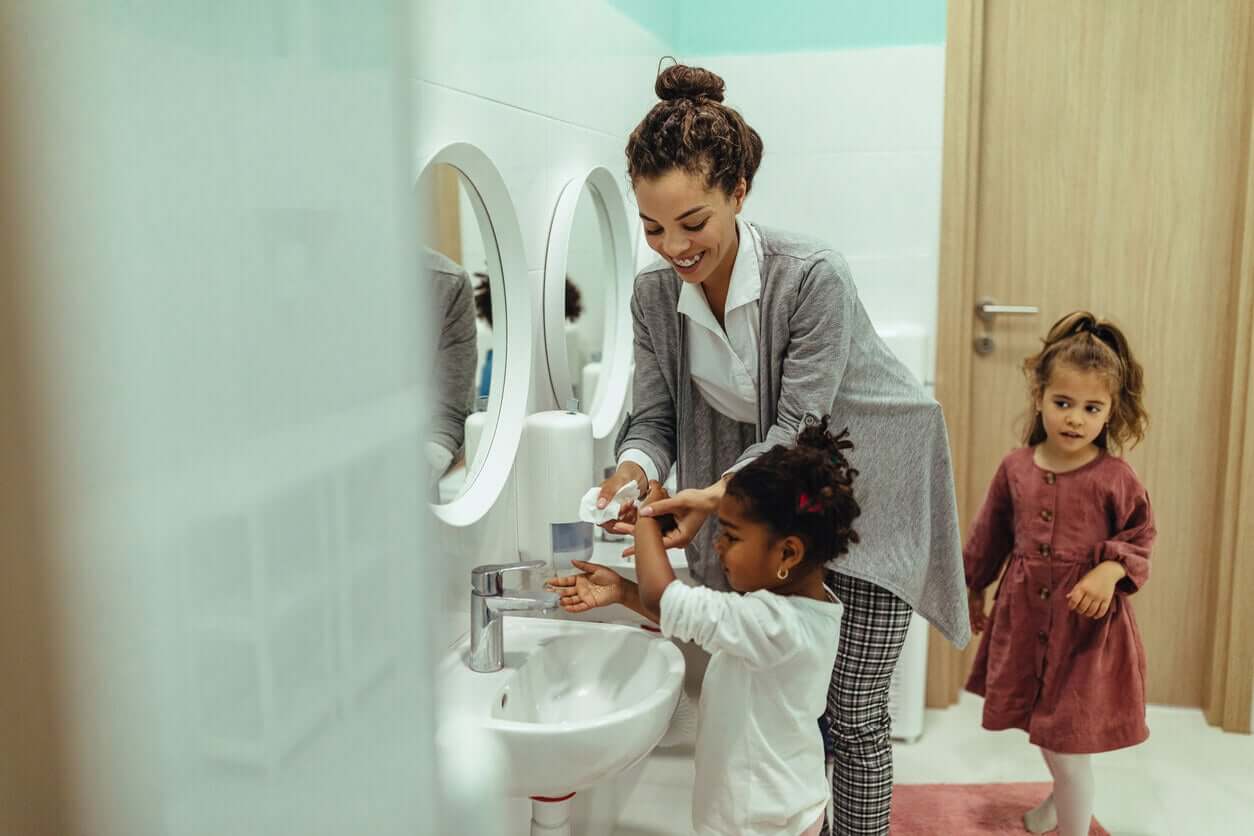Stomach Ulcers in Children: What You Need to Know


Written and verified by the pediatrician Marcela Alejandra Caffulli
We’re very used to hearing about stomach ulcers that affect adults, but how common are stomach ulcers in children? The answer is that’s they’re quite common, although much less so than in the elderly.
Currently, it’s estimated that between 2 and 8% of children can suffer from a peptic ulcer and this depends on several factors such as genetic predisposition, ethnicity, age, and the use of certain gastro-harmful medications.
Thanks to advances in digestive endoscopy in children, it’s been possible to determine the association between stomach ulcers and infection by the Helicobacter pylori bacteria. This has greatly favored treatment strategies for this disease.
Below, we’re going to tell you everything you need to know about this illness so you can be attentive and consult your doctor before if any symptoms appear in your children.
What are stomach ulcers?
The stomach is a digestive organ that’s responsible for processing food in order to absorb its nutrients and dispose of unnecessary elements. For example, the fibers contained in some vegetables.
To carry out its functions, this viscera has some special properties. Among them, its ability to secrete gastric acid (which is necessary in order to break down food) and its motility (which participates in the digestion process and favors the passage of the content to the intestine).
Like most digestive organs, the stomach lining is made up of three concentric layers. From the inside out, they are as follows:
- Gastric epithelium: Composed of cells with villi that absorb nutrients and secrete acid and protective mucus.
- Lamina propria: Formed by collagen.
- The muscular layer of the mucosa: Contains the muscle fibers.
In general, the gastric epithelium secretes balanced amounts of both acid and protective mucus. This prevents the stomach from degrading itself when it digests food.
But when for some reason, the acid production exceeds that of the mucus, corrosion of the gastric mucosa is produced from the epithelium to the muscular layer. Peptic (or gastric) ulcer occurs when mucosal damage reaches this last layer.
The causes of stomach ulcers in children

In pediatrics, the main cause of peptic ulcers is Helicobacter pylori infection. This bacteria is usually present in more than 90% of stomach biopsies performed in children with this disease.
However, this bacterium is very widespread among the population, and only 30% of those who carry it manifest symptoms or develop ulcers.
In addition to infection by this bacterium, there are other causes of stomach ulcers in children:
- The intake of analgesics (non-steroidal anti-inflammatory drugs, corticosteroids) or immunomodulators
- Mastocytosis
- G cell hyperplasia
- Stress (episodes of sepsis, large burns, or severe trauma)
- Zollinger Ellison syndrome
- Chronic renal failure
- Hyperparathyroidism
What are the signs and symptoms of stomach ulcers in children?
The symptoms of this disease vary according to the age of the child. In general, only a low percentage of those affected manifest some type of ailment and many times, this condition comes to light through indirect signs. For example, poor weight progress or chronic anemia.
In young children, the most common symptoms are:
- Irritability
- Refusal of food
- Constant vomiting and regurgitation
- Poor weight gain
- Digestive bleeds (for example, melena)
On the contrary, the manifestations of school children and adolescents are usually much more suggestive of a digestive illness:
- Diffuse abdominal pain, poorly located, somewhere between the sternum and the navel
- Repeated gas or belching
- Nausea and vomiting
- Weightloss
- Night cough or burning sensation while lying down
- Digestive bleeding (in general, vomiting with blood streaks)
What studies are done to confirm stomach ulcers in children?
First of all, the suspicion of the disease arises from the personal history of the child (ethnic group, relatives with an ulcer, drug treatments, other diseases) and by the presence of suggestive symptoms.
In any case, the definitive diagnosis is made through a biopsy of the stomach mucosa, which is obtained by means of a digestive endoscopy.
This procedure is invasive, as it requires intervention in an operating room and under anesthesia. But despite the risks, the benefits are significant:
- Digestive endoscopy allows doctors to corroborate the damage of the gastric mucosa typical of acid erosion and to rule out other diseases.
- It’s used to sample the gastric epithelium and evaluate the presence of Helicobacter pylori.
- It facilitates the detection of a bacterial strain resistant to the usual treatments.
- And finally, it’s the only standardized test in children and with diagnostic efficacy proven by the European Society for Pediatric Gastroenterology Hepatology and Nutrition (ESPGHAN).
Is there an effective treatment for stomach ulcers?
Yes, there’s a curative treatment for stomach ulcers in children and also for the eradication of the bacteria that usually cause it.
In any case, this will depend on the clinical picture and the findings of the endoscopy.
In general, medication isn’t prescribed before conducting this study, although some specialists may opt for the empirical treatment strategy. That’s to say, starting the medication when there’s clinical suspicion and corroborating the diagnosis after the improvement of the symptoms. However, this strategy is quite debatable when it comes to the pediatric population.
Helicobacter Pylori infection can be prevented!

Despite being a widely spread bacterium in society, not everyone carries it in their bodies. In fact, the chances of contagion increase when adequate environmental sanitation conditions aren’t maintained or in crowded contexts.
The main route of transmission is fecal-oral, which means that it occurs through direct contact between contaminated feces and the mouth. This can happen person to person (for example, among children in daycare or when an adult doesn’t sanitize their hands after changing a baby’s diaper) or also by the ingestion of water contaminated with feces.
Another method of contact described is oral-oral, since the carrier of the bacteria can contain it in their own saliva. By sharing glasses or kissing a person, it’s possible to contract the germ and become infected.
For this reason, the following is recommended in order to prevent Helicobacter pylori infection:
- Drink water from a safe source
- Wash hands before eating, after going to the bathroom, after changing diapers, and after handling pets
- Connect to your local sewer system
- Avoid sharing personal hygiene items or utensils among children
We’re very used to hearing about stomach ulcers that affect adults, but how common are stomach ulcers in children? The answer is that’s they’re quite common, although much less so than in the elderly.
Currently, it’s estimated that between 2 and 8% of children can suffer from a peptic ulcer and this depends on several factors such as genetic predisposition, ethnicity, age, and the use of certain gastro-harmful medications.
Thanks to advances in digestive endoscopy in children, it’s been possible to determine the association between stomach ulcers and infection by the Helicobacter pylori bacteria. This has greatly favored treatment strategies for this disease.
Below, we’re going to tell you everything you need to know about this illness so you can be attentive and consult your doctor before if any symptoms appear in your children.
What are stomach ulcers?
The stomach is a digestive organ that’s responsible for processing food in order to absorb its nutrients and dispose of unnecessary elements. For example, the fibers contained in some vegetables.
To carry out its functions, this viscera has some special properties. Among them, its ability to secrete gastric acid (which is necessary in order to break down food) and its motility (which participates in the digestion process and favors the passage of the content to the intestine).
Like most digestive organs, the stomach lining is made up of three concentric layers. From the inside out, they are as follows:
- Gastric epithelium: Composed of cells with villi that absorb nutrients and secrete acid and protective mucus.
- Lamina propria: Formed by collagen.
- The muscular layer of the mucosa: Contains the muscle fibers.
In general, the gastric epithelium secretes balanced amounts of both acid and protective mucus. This prevents the stomach from degrading itself when it digests food.
But when for some reason, the acid production exceeds that of the mucus, corrosion of the gastric mucosa is produced from the epithelium to the muscular layer. Peptic (or gastric) ulcer occurs when mucosal damage reaches this last layer.
The causes of stomach ulcers in children

In pediatrics, the main cause of peptic ulcers is Helicobacter pylori infection. This bacteria is usually present in more than 90% of stomach biopsies performed in children with this disease.
However, this bacterium is very widespread among the population, and only 30% of those who carry it manifest symptoms or develop ulcers.
In addition to infection by this bacterium, there are other causes of stomach ulcers in children:
- The intake of analgesics (non-steroidal anti-inflammatory drugs, corticosteroids) or immunomodulators
- Mastocytosis
- G cell hyperplasia
- Stress (episodes of sepsis, large burns, or severe trauma)
- Zollinger Ellison syndrome
- Chronic renal failure
- Hyperparathyroidism
What are the signs and symptoms of stomach ulcers in children?
The symptoms of this disease vary according to the age of the child. In general, only a low percentage of those affected manifest some type of ailment and many times, this condition comes to light through indirect signs. For example, poor weight progress or chronic anemia.
In young children, the most common symptoms are:
- Irritability
- Refusal of food
- Constant vomiting and regurgitation
- Poor weight gain
- Digestive bleeds (for example, melena)
On the contrary, the manifestations of school children and adolescents are usually much more suggestive of a digestive illness:
- Diffuse abdominal pain, poorly located, somewhere between the sternum and the navel
- Repeated gas or belching
- Nausea and vomiting
- Weightloss
- Night cough or burning sensation while lying down
- Digestive bleeding (in general, vomiting with blood streaks)
What studies are done to confirm stomach ulcers in children?
First of all, the suspicion of the disease arises from the personal history of the child (ethnic group, relatives with an ulcer, drug treatments, other diseases) and by the presence of suggestive symptoms.
In any case, the definitive diagnosis is made through a biopsy of the stomach mucosa, which is obtained by means of a digestive endoscopy.
This procedure is invasive, as it requires intervention in an operating room and under anesthesia. But despite the risks, the benefits are significant:
- Digestive endoscopy allows doctors to corroborate the damage of the gastric mucosa typical of acid erosion and to rule out other diseases.
- It’s used to sample the gastric epithelium and evaluate the presence of Helicobacter pylori.
- It facilitates the detection of a bacterial strain resistant to the usual treatments.
- And finally, it’s the only standardized test in children and with diagnostic efficacy proven by the European Society for Pediatric Gastroenterology Hepatology and Nutrition (ESPGHAN).
Is there an effective treatment for stomach ulcers?
Yes, there’s a curative treatment for stomach ulcers in children and also for the eradication of the bacteria that usually cause it.
In any case, this will depend on the clinical picture and the findings of the endoscopy.
In general, medication isn’t prescribed before conducting this study, although some specialists may opt for the empirical treatment strategy. That’s to say, starting the medication when there’s clinical suspicion and corroborating the diagnosis after the improvement of the symptoms. However, this strategy is quite debatable when it comes to the pediatric population.
Helicobacter Pylori infection can be prevented!

Despite being a widely spread bacterium in society, not everyone carries it in their bodies. In fact, the chances of contagion increase when adequate environmental sanitation conditions aren’t maintained or in crowded contexts.
The main route of transmission is fecal-oral, which means that it occurs through direct contact between contaminated feces and the mouth. This can happen person to person (for example, among children in daycare or when an adult doesn’t sanitize their hands after changing a baby’s diaper) or also by the ingestion of water contaminated with feces.
Another method of contact described is oral-oral, since the carrier of the bacteria can contain it in their own saliva. By sharing glasses or kissing a person, it’s possible to contract the germ and become infected.
For this reason, the following is recommended in order to prevent Helicobacter pylori infection:
- Drink water from a safe source
- Wash hands before eating, after going to the bathroom, after changing diapers, and after handling pets
- Connect to your local sewer system
- Avoid sharing personal hygiene items or utensils among children
All cited sources were thoroughly reviewed by our team to ensure their quality, reliability, currency, and validity. The bibliography of this article was considered reliable and of academic or scientific accuracy.
- Asociación Española de Pediatría. Manejo de la infección por Helicobacter pylori en la edad pediátrica. Anales de Pediatría 2021; vol 5, num 95. páginas 383 e1-e9. DOI: 10.1016/j.anpedi.2021.05.014. Disponible en: https://www.analesdepediatria.org/es-manejo-infeccion-por-helicobacter-pylori-articulo-S16954033210020
- Ramos Boluda E. Gastritis, úlcera y hemorragia digestiva. Pediatr Integral 2015; XIX (2): 83-91. Disponible en: https://www.pediatriaintegral.es/wp-content/uploads/2015/xix02/02/n2-083-091_Esther%20Ramos.pdf
- S Koletzko, F Richy, P Bontems, J Crone, N Kalach, M L Monteiro, F Gottrand, D Celinska-Cedro, E Roma-Giannikou, G Orderda, S Kolacek, P Urruzuno, M J Martı´nez-Go´mez, T Casswall, M Ashorn, H Bodanszky, F Me´graud, on behalf of the European Paediatric Task Force on Helicobacter pylori. Prospective multicentre study on antibiotic resistance of Helicobacter pylori strains obtained from children living in Europe. Gut 2006;55:1711–1716. doi: 10.1136/gut.2006.091272. Disponible en: https://www.ncbi.nlm.nih.gov/pmc/articles/PMC1856474/#
- Chelimsky G and Czinn S. Peptic Ulcer Disease in Children. Pediatrics in Review October 2001, 22 (10) 349-355; DOI: https://doi.org/10.1542/pir.22-10-349. Disponible en: https://pedsinreview.aappublications.org/content/22/10/349
- Sierra D, Wood M, Kolli S and Felipez LM. Pediatric Gastritis, Gastropathy, and Peptic Ulcer Disease. Pediatrics in Review November 2018, 39 (11) 542-549; DOI: https://doi.org/10.1542/pir.2017-0234. Disponible en: https://pedsinreview.aappublications.org/content/39/11/542.long?utm_source=TrendMD&utm_medium=TrendMD&utm_campaign=PedRev_TrendMD_0#sec-5
This text is provided for informational purposes only and does not replace consultation with a professional. If in doubt, consult your specialist.








